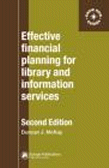 |
| About IR |
| Editors |
| Author instructions |
| Copyright |
| Author index |
| Subject index |
| Search |
| Reviews |
| Register |
| Home |
McKay, Duncan. Effective financial planning for library and information services. 2nd ed. London: Europa Publications, 2003. xi, 114 p. ISBN 0851424643. £15.99.
McKay's book is advertised as a 'concise guide to financial planning, with definitions of financial terms and the key processes involved, which also provides tips on how to present your budget most effectively to secure funding'. Even if the tips about presentation of a budget will not help to secure funding in difficult times, everything else is true to the fact.
The book itself is of a very modest size, but it holds quite an impressive overview of financial issues in the library or information unit in a business (or any other) organisation.
The author provides very laconic, matter of fact material about the budgeting, costing, and financial reporting processes. The book fleetingly (just in two short pages) points out the problem of moving costs from purchase to access and introduces spreadsheet use. There are also two appendixes that provide examples of a budget submission and spreadsheet use for financial management.
The introduction includes sound arguments for the necessity of financial management in information units and assures a reader that financial management is not beyond the skills of information professionals. The chapter on budgeting relates it to the overall planning process and explains basic budgeting methods as well as describes different types of budgets and links between them. A short chapter provides basis of cost analysis in a simple and easy to understand mode. More space is devoted to basic accounting and features of financial reporting.
The language is simple and not too technical, the book is illustrated with tables and figures featuring certain types of financial documents. An occasional formula does not seem scary in the context.
In a separate chapter, the author also lists organisations, which may be useful for seeking help in the financial management area. An interested person will find an extensive and up to date reading list and a list of journals dealing with special aspects of financial management. This feature might be of interest also to a researcher investigating a relevant problem as well as for a practitioner. Another useful feature is an index at the end of the book, which allows one to use it as a handbook.
As a reader I would complain about low quality of some illustrations. In some cases (pages 14 and 17) they are undecipherable. This reduces their functionality and also negatively affects the related text.
The intended audience is, of course, British librarians. They will benefit from the book most of all as all the examples and general material is based on British practices. Outside Great Britain the book can be used as a guide for understanding the basics of financial issues in information units and libraries. Even if they are not concerned with introduction of charges for the services, the importance of economics, effectiveness and efficiency, as well as financial management is growing everywhere.
Ona Norvaišaite
Vilnius University
Lithuania
October 2003
How to cite this review
Norvašaite, O. (2003) Review of: McKay, Duncan. Effective financial planning for library and information services. 2nd ed. London: Europa Publications, 2003. Information Research, 9(1), review no. R109 [Available at: http://informationr.net/ir/reviews/revs109.html]